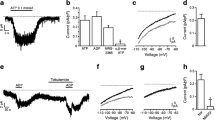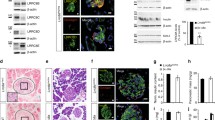Summary
In order to characterize the voltage-dependent Ca2+ channels of insulin secretory RINm 5F cells, we have studied the binding of the dihydropyridine (DHP) type Ca2+ antagonist PN 200-110 and its effect on insulin release. In the membrane preparation from RINm 5F cells [3H]-(+)-PN 200-110 bound to a high affinity binding site in a stereoselective manner (KD: 7.0 nM, Bmax: 858 fmol/mg protein). The benzothiazepine type Ca2+ antagonist D-cis-diltiazem increased the binding of [3H]-(+)-PN 200-110 in a temperature-dependent manner. The phenylalkylamine-type Ca2+ antagonist verapamil decreased PN binding with an IC50 of 100 μM. (+)-PN 200-110 inhibited KCl-(25 mM)-induced insulin release (IC50 = 10 nM), Effects on binding and hormone release occurred over comparable concentration ranges: 1 μM PN 200-110 produced 100% displacement and totally abolished depolarization-mediated insulin release. The N-type Ca2+-antagonist ω-conotoxin showed no effect on KCl-induced insulin release. The data suggest that in RINm 5 F cells only l-type Ca2+ channels are involved in the mechanism of depolarization-mediated insulin release.
Similar content being viewed by others
References
Aicardi G, Pollo A, Sher E, Carbone E (1991) Noradrenergic inhibition and voltage-dependent facilitation of ω-conotoxin-sensitive Ca channels in insulin secreting RINm5F cells. FEBS Lett 281:201–204
Bradford MM (1976) A rapid and sensitive method for the quantitation of microgram quantities of protein utilizing the principle of protein dye binding. Anal Biochem 72:248–254
Carafoli E (1987) Intracellular calcium homeostasis. Annu Rev Biochem 56:395–433
Dunn SMJ, Bladen C (1991) Kinetics of binding of dihydropyridine calcium channel ligands to skeletal muscle membranes: evidence for low-affinity sites and for the involvement of G proteins. Biochemistry 30:5716–5721
Gazdar AF, Chick WL, Oie HK, Sims HL, King DL, Weir GC, Lauxis V (1980) Continuous, clonal, insulin- and somatostatin-secreting cell lines established from a transplantable rat islet tumor. Proc Natl Acad Sci USA 77:3519–3523
Glossmann H, Ferry DR (1985) Assay for calcium channels. Methods Enzymol 109:521–550
Glossmann H, Striessnig J (1990) Molecular properties of calcium channels. Rev Physiol Biochem Pharmacol 114:1–105
Hofmann F, Nastainczyk W, Röhrkasten A, Schneider T, Sieber M (1987) Regulation of the L-type calcium channel. Trends Pharmacol Sci 8:393–398
Hosey MM, Lazdunski M (1988) Calcium channels: molecular pharmacology, structure and regulation. J Membr Biol 104:81–105
Komatsu M, Yokokawa N, Takeda T, Nagasawa Y, Aizawa T, Yamada T (1989) Pharmacological characterization of the voltage-dependent calcium channel of pancreatic β-cell. Endocrinol 125:2008–2014
McCleskey EW Fox AP, Feldman DH, Cruz IJ, Olivera BM, Tsien RW Yoshikami D (1987) ω-Conotoxin: direct and persistent blockade of specific types of calcium channels in neurons but not muscle. Proc Natl Acad Sci USA 84:4327–4331
Murphy BJ, Rogers CA, Sunahara RK, Lemaire S, Tuana BS (1990) Identification, characterization and photoaffinity labeling of the dihydropyridine receptor associated with the L-type calcium channel from bovine adrenal medulla. Mol Pharmacol 37:173–181
Praz GA, Halban PA, Wollheim CB, Blondel B, Strauss AJ, Renold AE (1983) Regulation of immunoreactive-insulin release from a rat cell line (RINm5F). Biochem J 210:345–352
Prentki M, Matschinsky FM (1987) Ca2+, CAMP, and phospholipidderived messengers in coupling mechanisms of insulin secretion. Physiol Rev 67:1185–1248
Quar J, Barhanin J, Romey G, Henning R, Lerch U, Oekonomopulos R, Urbach H, Lazdunski M (1988) A novel high affinity class of Ca2+ channel blockers. Mol Pharmacol 33:363–369
Safayhi H, Kühn M, Koopmann I, Ammon HPT (1989) CGS 9343B and W7 (calrnodulin antagonists) inhibit KCI-induced increase in cytosolic free calcium and insulin secretion of RINm5F cells. Naunyn-Schmiedebergs Arch Pharmacol 339:8–13
Sullivan SJ, Schonbrunn A (1988) Distribution of somatostatin receptors in RINm5F insulinoma cells. Endocrinology 122:1137–1145
Tsien RW Ellinor PT, Horne WA (1991) Molecular diversity of voltage-dependent Ca2+ channels. Trends Pharmacol Sci 145:349–354
Velasco JM (1987) Calcium channels in rat insulin-secreting RINm5F cell line. J Physiol (Lond) 398:15P
Wollheim CB, Pozzan T (1984) Correlation between cytosolic free Ca2+ and insulin release in insulin secreting cell line. J Biol Chem 259:2262–2267
Yaney GC, Stafford GA, Henstenberg JD, Sharp GWG, Weiland GA (1991) Binding of the dihydropyridine calcium channel blocker (+)-[3H]-isopropyl-4-(2,1,3-benzoxadiazol-4-yl)-1,4-dihydro-5-methoxy-carbonyl-2,6-dimethyl-3-pyridinecarboxylate (PN 200–110) to RINm5F membranes and cells: characterization and functional significance. J Pharmacol Exp Ther 258:653–662
Author information
Authors and Affiliations
Additional information
Some of the data reported here were presented at the 27th Annual Meeting of the European Association for the Study of Diabetes, Dublin, 10–14 September 1991
Correspondence to: H. Safayhi at the above address
Rights and permissions
About this article
Cite this article
Roenfeldt, M., Safayhi, H. & Ammon, H. KCl-induced insulin secretion from RINm5F cells is mediated through Ca2+ influx along L-type Ca2+ channels. Naunyn-Schmiedeberg's Arch Pharmacol 346, 527–531 (1992). https://doi.org/10.1007/BF00169008
Received:
Accepted:
Issue Date:
DOI: https://doi.org/10.1007/BF00169008




